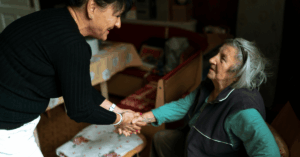According to the Alzheimer Society of Canada, “a restraint is anything that restricts or controls a person’s movement or behaviour.” However, the Alzheimer Society of Canada also cautions that restraints should be used ONLY as a last resort.
If the use of restraint is considered, care must be taken to ensure that they are used appropriately, with supervision, and as minimally as possible. Further, the use of restraints should not be seen as a permanent and long-term solution for managing dementia-related behaviours. Direct care professionals should ensure that ongoing and regular assessments are done to determine the appropriateness of use as well as the impact on the person’s health and overall well-being.
Physical Restraints: Are They Effective in Preventing Falls Among People with Dementia?
Physical restraints include pen-release seat belts, bedrails, vests, or chairs that prevent individuals with dementia who are at high risk for falls, from getting up or moving around on their own without supervision. They are intended mostly for fall-prevention and/or management of disruptive behaviors – to keep themselves and other people around them safe.
However, it is also important to keep in mind that physical restraints can lead to a decline in a person’s physical and psychological well-being. Prolonged immobilization can result in muscle atrophy, pressure sores, and increased dependence on caregivers.
The sense of confinement can also lead to feelings of frustration, agitation, loss of dignity, unnecessary stress, anxiety, fear, and depression for anyone, especially people living with dementia.
Chemical Restraints
Chemical restraints involve the administration of medication to sedate or calm a patient with dementia exhibiting challenging behaviors. Medications such as antipsychotics, sedatives, or benzodiazepines are commonly used for this purpose.
One of the main issues with chemical restraints is the potential for serious side effects including increased risk of stroke, heart problems, and even higher mortality rate in dementia patients. Sedatives can lead to drowsiness, confusion, falls, and a decline in cognitive function, exacerbating the very symptoms they are meant to alleviate.
It’s also important to note that antipsychotic drugs have limited effectiveness in managing behavioral symptoms in dementia. They may suppress symptoms temporarily but do not address the underlying causes. Wandering, hoarding, and repetitive behaviours, for example, cannot be managed with pharmacological interventions. According to a January 2022 article, “Non-Pharmacological Interventions for Wandering/Aberrant Motor Behaviour in Patients with Dementia,” published in the scientific journal, Brain Sciences, “Non-pharmacological interventions should be also considered as a first-line solution for the wandering because current pharmacological treatment has serious side-effect.” These side effects can include tremors of the hands, feet, and neck; muscle rigidity, slowness in gait; and, increased restlessness of the legs and feet, among others.
Understanding the Fall Risk in Dementia
Individuals with dementia are at an elevated risk of falls due to a combination of factors. Cognitive decline can impair judgment and spatial awareness, making it difficult for them to identify and navigate obstacles. Their motor skills may decline, leading to gait disturbances and balance problems.
Lastly, behavioral symptoms like anxiety, hallucinations, or agitation can trigger sudden movements, increasing the likelihood of accidents.
Alternatives to Physical and Chemical Restraints
Environmental Modifications to Prevent Falls
If a person living with dementia is still highly mobile/ambulatory and independent, the use of physical restraints may cause more harm than good. Not only will the use of physical restraints trigger agitation, anxiety, frustration, and anger in the person, but their attempt to free themselves of their restraints may cause physical injury.
An alternative can be creating a safe, well-lit, and obstacle- and barrier-free environment that can reduce the likelihood of tripping or accidents. Using clearly labeled doors and signs can also be helpful.
Person-Centred Needs Assessment and Management
Understanding the cause of gait disturbances or balance challenges is key to ensuring safety while supporting the person’s mobility. Are they wearing the right shoes? Is there a problem with their feet or toe nails? Do they have visual or hearing impairment and can these be corrected to allow them to continue moving freely and independently?
Spatial awareness refers to the ability to perceive and navigate one’s surroundings accurately. This includes recognizing objects, understanding distances, and maintaining a sense of direction. People with dementia may become disoriented in familiar places, increasing the likelihood of accidents and falls. They may have trouble recognizing the layout of their own homes, which can lead to confusion and agitation.
Simplifying the home layout, use of contrasting colours to help with depth perception for example, and adding clear labels are some alternatives that can help reduce the risk of falls and accidents. Cognitive exercises and physical activity may also support spatial awareness retention.
Therapeutic Reasoning™ and Communication Techniques to Manage Changed Behaviours
There is always a reason behind the behaviour.
For individuals living with dementia, especially those who have reduced or lost the ability for speech and language, behaviour becomes their means of communication. Education and training caregivers in effective communication and understanding dementia behaviours can prevent or de-escalate challenging behaviors in individuals with dementia.
Non-pharmacological Approaches
Non-pharmacological approaches, such as behavior modification, using art, music or other activities of interest, as well as physical activity, can be effective in managing changed behaviors in dementia without the side effects associated with antipsychotic medications.
Balancing Safety with Autonomy and Independence of People Living with Dementia
The decision as to whether or not to use physical and chemical restraints should not be taken lightly. Finding a balance between ensuring safety and preserving autonomy and dignity is essential. Caregivers and healthcare professionals must consider the individual needs of each person (person-centred care) with dementia and use strategies that are appropriate and tailor-made for the individual. There is no “cookie-cutter” approach in dementia care.
Restraints should be used sparingly and in accordance with legal and ethical guidelines. Regular reassessment of the need for restraints and ongoing communication with the individual’s family and healthcare team are essential components of responsible restraint use. The use of restraints, of any kind, should NOT be a first-line response to managing responsive behaviours in dementia, nor should it be pursued as a long-term or permanent solution for managing dementia-related behaviours.
At Dementia Solutions, we’ve made it our mission to demystify dementia behaviour and continue to explore person-centred, creative, non-pharmacological solutions to manage dementia-related behaviours. We believe that awareness creation and skill-building through education is the most effective and powerful tool we have to promote and maintain the well-being of both the person with dementia and their caregiver.
If you need support in your caregiving experience or would like to learn more about our educational opportunities, please reach out to us at Info@DementiaSolutions.ca and we would be more than happy to support you.
DISCLAIMER:
The contents of this blog are provided for information purposes only. They are not intended to replace clinical diagnosis or medical advice from a health professional.




One Response
Within the U.S., I am at odds with a doctor that has my brother (70 yo; vascular dementia dx 3 yrs post) on Risperdal at a daily dose of 5mg. He is presently in a “Memory Care” facility. Am I wrong in seeing my brother now just being a walking zombie?